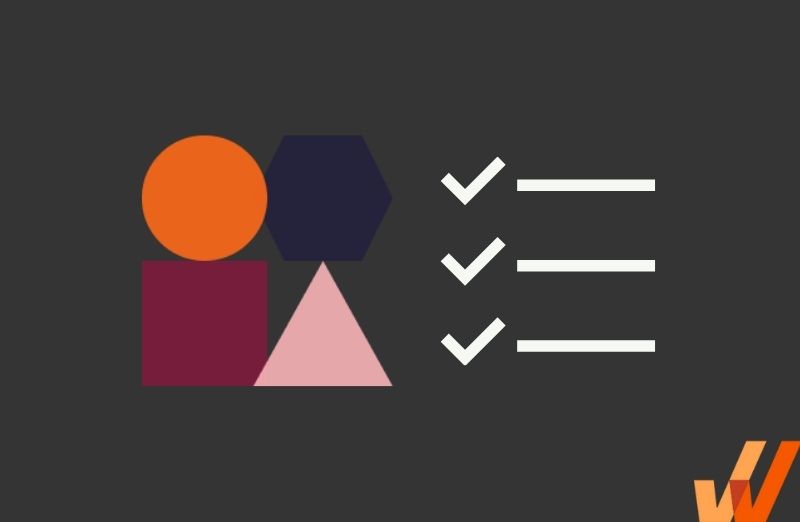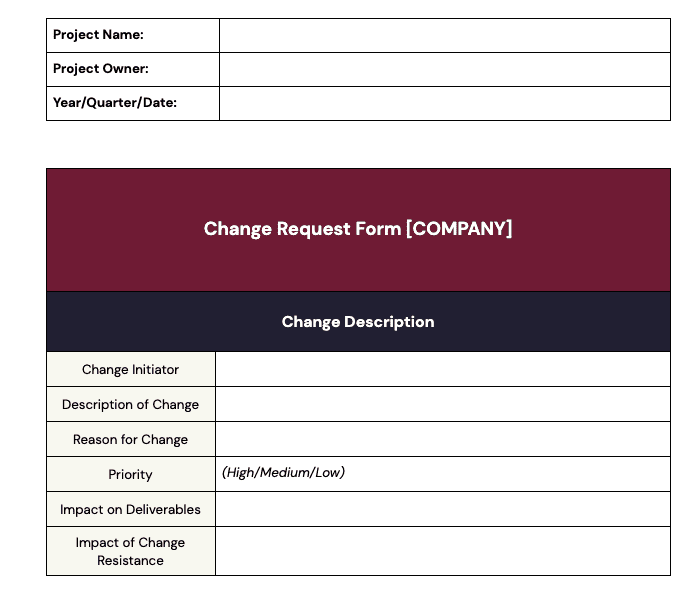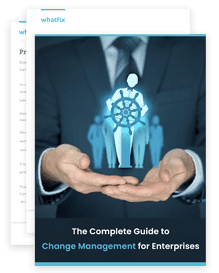
Implementing organizational change is complicated, but creating a plan doesn’t have to be if you have the right change management plan template to leverage. While the actual implementation process will be influenced by a variety of factors, all organizational changes will begin with a similar foundation.
In order to build that change management foundation, you’ll need a blueprint you can refer to which will remind you why the change is needed, who you can count on for support, how you can monitor the progress, and what communication and training strategies you can use for reinforcement.
These change management plan templates will help you create that blueprint. To build a strong foundation for your change, fill each template with as much detail as possible.
Free Change Management Plan Checklists & Templates
✓ Thank you, the template will be sent to your email
7 Useful Change Management Plan Templates in 2024
Here are 6 of the most useful change management plan templates in 2024 – plus a bonus ebook download to help craft your enterprise change strategy.
Download and use these templates for your own organizational change initiatives – let’s get started.
1. Change Proposal Template

Change Proposal Template | Download Template
Before making the plans needed to roll out a change, make sure you understand why the change is needed. The motive behind or the reason for the change will influence every step of your planning process.
Getting started with a change proposal template, regardless of whether or not the change has already been approved, will force you to really dig into the ‘why’ behind the change. Once you’ve completed this template, you’ll be ready to justify the change and help others understand it as well.
This change management plan example also includes a section for potential benefits and potential negatives. Use this section to show your thought process behind the change. Share your own concerns while still rationalizing the need for the change by showing the benefits. Of course, no change can be 100% positive, but this section shows that you have considered the pros and cons and still believe the change is necessary.
Once you know why the change needs to happen, it’s time to designate change leaders who will help support the change.
This change proposal template includes:
- Proposed Change – What will change? This should be a brief explanation of the proposed change. Make sure to address not only what will change but also who it will affect and when it will take place.
- Reason for Change – Why should this change happen? When explaining the reason for the change, be specific. Explain exactly why the change is necessary. Remember, you need to fully justify the need for the change. Use this section to address anticipated concerns and/or resistance to drive home the ‘why’ for this change.
- Intended Outcome(s) – What would the be specific outcome of a successful change? Consider results such as reduced labor costs, improved employee experience, increased productivity, etc. depending on the change situation and sometimes the executives involved.
- Estimated Duration – How long will it take? Provide an estimate of how much time will be required to implement and solidify the proposed change. Be sure to include the time related to planning for the change, communicating the change to those affected by it, and transition periods.
- Estimated Costs – How much will the change implementation cost? Calculate the estimated total costs associated with the change. Costs to consider include things such as labor, additional staffing needs, technology, and outside consultation.
- Additional Factors to Consider – What other areas of the company might this change affect? Anything of note that is not covered by the previous categories belongs in this section. For example, if the proposed change involves hiring new talent, the organizational chart may need to be updated, and shifts to the organizational hierarchy could affect employee morale.
2. Change Leaders Template

Change Leaders Template | Download Template
As per this change management plan template, identifying your champions for change is fundamental. In order for the intended change to be adopted, influential people must actively support, communicate, and monitor the change. Determine your change leaders early on, so you can include them in your plans.
This change leaders template includes:
- Change Leaders – Who will be your biggest advocate for the change? Change leaders need to be influential people within your organization who can help you convey both the reason for the change and how it will be implemented. Choose great communicators. Remember, change management communication can be the deciding factor between change adoption and change failure. Most importantly, leaders need to be able to provide ongoing support throughout the transition.
- Reason for Involvement – Why should this person be a change leader? Consider how they will support the change. For example, if you plan to introduce new software, the head of the IT department might be a designated change leader. On the other hand, if you are restructuring internal teams, look for leaders within the HR department.
- Key Responsibilities – What is their role with regards to the change? Responsibilities might include providing training on new tools, setting up meetings to gather feedback on the implementation process, or monitoring how the change affects different aspects of the organization. Play to their strengths. Moreover, consider who each change leader will be working with directly.
- Related People – Who will work with each change leader? Keep in mind that people react better to change when they hear about it from their direct supervisor. Employees need to feel connected to the change. By pointing employees to their direct change leader, you ensure that they feel heard.

3. Change Management Communications Plan Template

Change Communication Plan Template | Download Template
No plan is complete without a communications strategy. Ultimately, the people who are affected by a change are the ones responsible for its success, so creating a change communication strategy is crucial.
Treat this change management plan template as a living document. As you confront resistance to change and overcome obstacles, you will need to add communication actions to your plan.
The change management communications plan template includes:
- Change Management Model(s) – Which change management model or combination of models will be used to implement the change? The model(s) you choose will influence your communication strategy. For example, the Nudge Theory depends heavily on suggestive communication, nudging your employees towards the desired result. The Kübler-Ross Change Curve, on the other hand, addresses the people affected head-on and prepares you for emotional reactions to change.
- Change Leaders – Who will communicate the change? Refer to your Change Leaders template to fill in this section.
- Events or Actions That Require Communication – What needs to be communicated? Initial announcements, pieces of training, meetings, deadlines? Be ready to add action plans as needed. Planning is helpful, but adjusting your strategy along the way is imperative.
- Date Of Communication – When will it happen? This section is especially useful for gradual transitions that require a ramp-up period. Use this to map out key events that will call for communication.
- Change Leader(s) in Charge of Communication – Who is responsible for the communication? Choose your change leaders based on their skill set and relationship to those receiving the communication. For instance, the CEO might announce the change to the entire company, while the Director of Marketing would talk to their department about how the change will affect them specifically.
- Audience – Who is the target audience? Design your communication to answer questions, like What’s in it for me? (WIIFM) and What does it mean to me? (WDIMTM), for your intended audience.
- Reason for Communication – Why is it necessary? You should know the desired outcome of each conversation before you initiate it. For example, a training event is designed to teach the audience something, while a meeting might be scheduled so that change leaders can listen to employee feedback.
- Method of Communication – How will it be communicated? Use multiple channels for communications, such as video demonstrations, small team meetings, and internal chats. People like to receive information in different ways, so it’s beneficial to use a variety of communication methods.
4. Change Management Analysis Template

Change Analysis Template | Download Template
Implementing different types of organizational change involves a variety of steps, each of which needs to be analyzed individually. This template helps you monitor the implementation process.
Tracking the steps allows you to judge the success or failure of each one and adjust your plan accordingly. Refer to the PDCA Cycle to troubleshoot any issues in change implementation.
The change analysis template plan includes:
- Change Management Model(s) – What change management model(s) will be used? Keep the chosen model(s) in mind to ensure your analysis strategy aligns with the model.
- Event or Action – What will be analyzed? These will often align with the events or actions in the communications plan. As previously stated, every conversation should have a desired outcome. The analysis change management plan template helps you judge if that outcome was achieved.
- Original Date of Event or Action – When did it happen? Tracking when change-related events occurred allows you to monitor overall progress.
- Date of Analysis – When was it analyzed? While this date will often be the same as the event itself, it’s possible to decide later on that further analysis would be valuable.
- Issues – What could have gone better? Maybe the training was overly complicated, or the video explaining the change was too long. It’s okay to make some mistakes along the way as long as you take a step back to consider how you can improve the process next time.
- Successes – What went well? Even small wins are worth celebrating, so don’t forget to highlight the positives. Plus, successes will point you in the right direction for future aspects of your change implementation.
- Action Needed – What needs to happen now? Talk to your change leaders about the issues and discuss how to address them. If everyone left the two-hour training session confused, maybe you need to break it into four 30-minute sessions instead.
5. Change Management Tools Template

Change Management Tools Template | Download Template
Many organizational changes are supported by change management tools. Not only should your plans clearly identify the tools that will be involved in the change, but they should also provide a justification for their use and who will be using each tool.
The change management tools template includes:
- Change Management Model(s) – Which change management models will be referred to? While the chosen model will not directly affect the tools used, you should refer back to the model throughout the transition.
- Tool – What tool will be used? Tools can be something as simple as a Slack channel dedicated to discussions related to the change or something more detailed, like a task management tool such as Trello for tracking steps in the change process. For a more complicated change, leverage a digital adoption platform (DAP).
- Purpose of Tool – Why is this tool necessary? For example, if you are transitioning to Salesforce, Whatfix’s digital transformation tool will provide ongoing interactive guidance to streamline user onboarding. You may also employ tools for training purposes, for instance, using Vimeo to share videos that discuss the benefits of Salesforce.
- Change Leader – Who will be in charge of the tool? Designate change leaders who will be responsible both for using the tool and educating others about it.
- Users – Who will use the tool? In the case of the Slack channel, everyone affected by the change would be considered a user. Vimeo, on the other hand, may only be used by change leaders who are publishing videos to educate their teams about the change.
- Cost of Tool – What is the price? The cost of the tool will factor into the cost of the overall change and could also affect the decision of whether or not the tool is truly necessary.
6. Change Management Training Plan Template

Change Training Plan Template | Download Template
All changes call for some form of training to support change adoption. This example is designed to help you prepare for all the necessary change management training and support throughout the transition.
The change training plan template includes:
- Change Management Model(s) – Which model(s) is being used for this change?
- Type of Training – What will the training cover? Keep it simple — just the main focus of the training.
- Audience – Who will receive the training? Even though some training may need to involve large groups of people, consider breaking the training into smaller groups that are led by specific change leaders. This will allow you to better address the WIIFM and WDIMTM questions for each specific group.
- Intended Outcome – What will the training achieve? Be specific about the goals of the training. Instead of saying, “this training will teach employees about Salesforce and marketing,” add in details such as “this training will provide an overview of all Salesforce features and ensure that users understand the basic navigation. Then, we will cover the marketing capabilities in-depth.”
- Method of Delivery – How will the training be done? While some training might be done in person, others could be delivered through video tutorials, blogs, or even self-guided learning options.
- Tools & Equipment – Will the training require any tools or equipment? Refer to your tools template for which tools have been bookmarked for training purposes.
- Training Leader – Who will be responsible for the training? The training leader is in charge of making sure the training happens as scheduled, as well as the person who may administer the training.
- Planning Time – How much time is needed to plan? A well-thought-out training will be better received. Reserve time to properly plan it out.
- Duration of Training – How long will the training take? Of course, it’s helpful to know the duration for the sake of scheduling, but filling in this field will also force you to consider whether or not the length of the training is appropriate. For instance, if the training requires three hours, you may want to break it into three sessions to improve comprehension.
- Cost of Training – How much will the training cost? If the training itself will incur additional costs, such as hiring an outside consultant, note it here. Be careful not to roll in any costs related to tools, as those will be accounted for on your tools template.
7. Change Request Form Template

Change Request Template | Get the Template
- Controlling an upcoming or current change project requires extensive planning, resources, and documentation. You can utilize a change control and request form to minimize manual administration work and avoid project confusion.
Included in this change request form template are sections to help you:
- Control unnecessary change projects.
- Avoid duplicate work.
- Understand why a change is needed.
- See the impact analysis of a change project request.
- Have a leader sign off on change requests.
8. The Complete Guide to Enterprise Change Management
Complete Guide to Enterprise Change Management | Download Template
This 40+ page whitepaper covers everything there is to know on tackling a large, enterprise change project.
From the various models of change, best practices for implementation, a breakdown of various tools and exercises, and much more.

This old adage most certainly applies to change management. After all, you can’t expect a change to be successful if you don’t have a solid plan that covers everything from the announcement of the change to the training needed to make that change effective.
Once you’ve filled out the above change management plan templates, you’ll have a better idea of how the change implementation process will work. You can use the above templates for free by downloading them here.
Whatfix drives adoption and trains employees on enterprise change initiatives. With Whatfix, create no-code in-app content such as guided walkthroughs, task lists, tooltips, and self-help wikis.
Learn more about Whatfix for change management now!
Request a demo to see how Whatfix empowers organizations to improve end-user adoption and provide on-demand customer support
Thank you for subscribing!
Thank you for subscribing!



